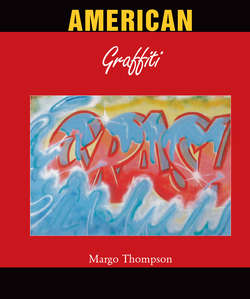Читать книгу American Graffiti - Margo Thompson - Страница 13
Subway Writers
RAMMELLZEE
ОглавлениеQueens-based RAMMELLZEE believed in the power of writing as a vehicle to reconfigure language and the circuits of power it supports, although he was not active in the yards. He described his theory of writing, ‘Ikonoklast Panzerism’, to art critic Nicolas A. Moufarrege in a 1982 interview in Arts magazine. ‘Panzerism’, he said, ‘is connected to panzer, the tank. Armor, an armored mechanism. So when I add the – ism to panzer, it means the practice of armament’. He said he substituted K for the C in ‘iconoclast’ because it was a more ‘evolved’ letter: ‘…the letter “c” in its formation is an incomplete cipher: 60 degrees are missing. A “k” is a formation based on the foki [sic] of it; a certain kind of science based on the knowledge of formation mechanics…’ Awareness of the structure of letters allows the writer to ‘arm’ them, as he believed the medieval monks had done with the points in their letters: ‘When they got to the points in the Gothic texts, we extended and made arrows’. Writers, he claimed, knew Gothic script from newspaper banners, such as the Long Island Press and The New York Times. The transformation of Gothic letter to wild-style was not necessarily deliberate, but to RAMMELLZEE it was undeniable: ‘All you got to do is look at that [the newspaper banner] and what we did on the trains: same thing. You’ve got the connection right there but we did ours in the dark and made that connection; therefore that connection is subconscious’. His own tag had evolved to be a ‘military function and formation, because when I draw it, it is not R, A, M, M, E, L, L, Z, E, E; it is R, A, M, M, Sigma, L, L, Z, Sigma, Sigma. We have turned Epsilon into Sigma’.[67] He espoused that letters are in themselves meaningful and properly understanding the concepts they signify allows one to unlock the secrets of the universe. This belief is reminiscent of part of the doctrine of the Five Percent Nation, an offshoot of the Nation of Islam that called upon African Americans to empower themselves and become self-sufficient, although he denied the influence. He collaborated with A-ONE, KOOR and TOXIC to develop his philosophy, and later was dismissive of writers such as DONDI, FUTURA, and LEE, who focused on imagery at the expense of letters when they began to paint on canvas.[68]
67
All quotations from Nicolas A. Moufarrege, “Lightning Strikes (Not Once but Twice): An Interview with Graffiti Artists,” Arts 57, no. 3 (November 1982), 90–2.
68
Interview with Carlo McCormick, 27 July 2006.
